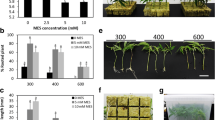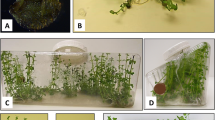Abstract
Cannabis micropropagation is an effective method for producing clean plants in the new and expanding cannabis industry. However, existing protocols are not efficient enough to mass propagate for industry demands and to preserve large numbers of elite cultivars. This research was designed to validate optimal mineral nutrition for cannabis micropropagation. Currently, Murashige and Skoog (MS) basal salts are used in commercially available cannabis medium. Three mineral nutrient factors were defined from MS salts: ammonium nitrate, potassium nitrate, and mesonutrients (CaCl2·2H2O, KH2PO4, MgSO4·7H2O). A total of 20 treatments (MS1-20) were designed, and each factor was varied over a range of concentrations. Leaf canopy area, shoot fresh weight, and multiplication number were measured to quantify the effects of mineral nutrients on the in vitro growth of three cannabis cultivars. All cultivars responded positively to increased nitrogen and mesonutrients (MS6) relative to MS medium. Plantlets grown on MS6 exhibited a significant increase in canopy area and fresh weight in two out of three studied cultivars. Additionally, an increase in multiplication number was noted on MS6 with an average increase in shoots per explant of 52% across three cultivars. The addition of potassium silicate (4.86 mM) to MS6 media reduced hyperhydricity symptoms in three hyperhydric cultivars. An improved root induction was observed on inert media, rockwool, and Oasis foam plugs when compared to standard culture media (½ MS containing 2.4 µM IBA and MS containing 2 µM m-topolin) that are routinely used as cannabis rooting media. Plantlets grown in rockwool resulted in healthy shoots and a high root fresh weight after 4 to 6 wk with mineral nutrient solution while plantlets grown on standard culture media did not produce roots during this period. Together, this study presents an end-to-end efficient procedure for cannabis micropropagation and preservation to be used in industrial large-scale production.




Similar content being viewed by others
Change history
21 January 2023
The file originally online for Supplementary file 1 has been replaced by the one now available.
References
Adamek K, Jones AMP, Torkamaneh D (2021) Accumulation of somatic mutations leads to genetic mosaicism in cannabis. Plant Genome 15:e20169. https://doi.org/10.1002/tpg2.20169
Adhikary D, Kulkarni M, El-Mezawy A, Mobini S, Elhiti M, Gjuric R, Ray A, Polowick P, Slaski JJ, Jones MP, Bhowmik P (2021) Medical cannabis and industrial hemp tissue culture: present status and future potential. Front Plant Sci 12:275
Canny MJ, Huang CX (2006) Leaf water content and palisade cell size. New Phytol 170:75–85. https://doi.org/10.1111/j.1469-8137.2005.01633.x
Chandra S, Lata H, Khan IA, ElSohly MA (2017) Cannabis sativa L.: botany and horticulture. In: Cannabis sativa L.-Botany and Biotechnology. Springer, pp 79–100
Chaohua C, Gonggu Z, Lining Z, Chunsheng G, Qing T, Jianhua C, Xinbo G, Dingxiang P, Jianguang S (2016) A rapid shoot regeneration protocol from the cotyledons of hemp (Cannabis sativa L.). Ind Crops Prod 83:61–65
Driver JA, Kuniyuki AH (1984) In vitro propagation of Paradox walnut rootstock. HortScience 19:507–509
El-Hawaz R, Park D, Bridges WC, Adelberg J (2016) Optimizing in vitro mineral nutrition and plant density increases greenhouse growth of Curcuma longa L. during acclimatization. Plant Cell Tiss Org Cult 126:33–42
Holmes JE, Lung S, Collyer D, Punja ZK (2021) Variables affecting shoot growth and plantlet recovery in tissue cultures of drug-type Cannabis sativa L. Front Plant Sci 12:732344. https://doi.org/10.3389/fpls.2021.732344
Kevers C, Gaspar T (1986) Vitrification of carnation in vitro: changes in water content, extracellular space, air volume, and ion levels. Physiologie Végétale (paris) 24:647–653
Kodym A, Leeb CJ (2019) Back to the roots: protocol for the photoautotrophic micropropagation of medicinal Cannabis. Plant Cell Tiss Org Cult 138:399–402. https://doi.org/10.1007/s11240-019-01635-1
Kozai T (2010) Photoautotrophic micropropagation-environmental control for promoting photosynthesis. Prop Ornam Plants 10:188–204
Lata H, Chandra S, Khan I, ElSohly MA (2009) Thidiazuron-induced high-frequency direct shoot organogenesis of Cannabis sativa L. In Vitro Cell Dev Biol - Plant 45:12–19. https://doi.org/10.1007/s11627-008-9167-5
Lata H, Chandra S, Techen N et al (2010) Assessment of the genetic stability of micropropagated plants of Cannabis sativa by ISSR markers. Planta Med 76:97–100. https://doi.org/10.1055/s-0029-1185945
Lata H, Chandra S, Techen N et al (2016) In vitro mass propagation of Cannabis sativa L.: a protocol refinement using novel aromatic cytokinin meta-topolin and the assessment of eco-physiological, biochemical and genetic fidelity of micropropagated plants. J Appl Res Med Aromat Plant 3:18–26. https://doi.org/10.1016/j.jarmap.2015.12.001
Lubell-Brand JD, Kurtz LE, Brand MH (2021) An in vitro–ex vitro micropropagation system for hemp. HortTechnology 31:199–207. https://doi.org/10.21273/HORTTECH04779-20
Mestinšek-Mubi Š, Svetik S, Flajšman M, Murovec J (2020) In vitro tissue culture and genetic analysis of two high-CBD medical cannabis (Cannabis sativa L.) breeding lines. Genetika 52:925–941
Miller RG, Tate CR, Mallinson ET, Scherrer JA (1991) Xylose-lysine-tergitol 4: an improved selective agar medium for the isolation of Salmonella. Poultry Sci 70:2429–2432
Monthony AS, Page SR, Hesami M, Jones AMP (2021) The past, present and future of Cannabis sativa tissue culture. Plants 10:185
Movahedi M, Torabi S (2015) The effect of different concentrations of TDZ and BA on in vitro regeneration of Iranian cannabis (Cannabis sativa) using cotyledon and epicotyl explants. J Plant Mol Breed 3:20–27
Murphy R, Adelberg J (2021) Physical factors increased quantity and quality of micropropagated shoots of Cannabis sativa L. in a repeated harvest system with ex vitro rooting. In Vitro Cell Dev Biol - Plant 57:923–931
Niedz RP, Evens TJ (2007) Regulating plant tissue growth by mineral nutrition. In Vitro Cell Dev Biol - Plant 43:370–381
Niedz RP, Evens TJ (2016) Design of experiments (DOE)—history, concepts, and relevance to in vitro culture. In Vitro Cell Dev Biol - Plant 52:547–562
Niedz RP, Hyndman SE, Evens TJ, Weathersbee AA (2014) Mineral nutrition and in vitro growth of Gerbera hybrida (Asteraceae). In Vitro Cell Dev Biol - Plant 50:458–470
Page SRG, Monthony AS, Jones AMP (2021) DKW basal salts improve micropropagation and callogenesis compared with ms basal salts in multiple commercial cultivars of Cannabis sativa. Botany 99:269–279. https://doi.org/10.1139/cjb-2020-0179
Piunno KF, Golenia G, Boudko EA, Downey C, Jones AMP (2019) Regeneration of shoots from immature and mature inflorescences of Cannabis sativa. Can J Plant Sci 99:556–559. https://doi.org/10.1139/cjps-2018-0308
Poothong S, Reed BM (2015) Increased CaCl2, MgSO4, and KH2PO4 improve the growth of micropropagated red raspberries. In Vitro Cell Dev Biol - Plant 51:648–658
Punja ZK (2021) Emerging diseases of Cannabis sativa and sustainable management. Pest Manage Sci 77:3857–3870
Purohit SD, da Silva JA, Habibi N (2011) Current approaches for cheaper and better micropropagation technologies. Int J Plant Dev Biol 5:1–36
Reed BM, Wada S, DeNoma J, Niedz RP (2013) Improving in vitro mineral nutrition for diverse pear germplasm. In Vitro Cell Dev Biol - Plant 49:343–355
Richez-Dumanois C, Braut-Boucher F, Cosson L, Paris M (1986) Multiplication végétative in vitro du chanvre (Cannabis sativa L.). Application à la conservation des clones sélectionnés. Agronomie 6:487–495. https://doi.org/10.1051/agro:19860510
Sivanesan I, Park SW (2014) The role of silicon in plant tissue culture. Front Plant Sci 5:571
Sivanesan I, Song JY, Hwang SJ, Jeong BR (2011) Micropropagation of Cotoneaster wilsonii Nakai—a rare endemic ornamental plant. Plant Cell Tiss Org Cult 105:55–63
Smýkalová I, Vrbová M, Cvečková M, Plačková L, Žukauskaitė A, Zatloukal M, Hrdlička J, Plíhalová L, Doležal K, Griga M (2019) The effects of novel synthetic cytokinin derivatives and endogenous cytokinins on the in vitro growth responses of hemp (Cannabis sativa L.) explants. Plant Cell Tiss Org Cult 139:381–394
Soundararajan P, Manivannan A, Cho YS, Jeong BR (2017) Exogenous supplementation of silicon improved the recovery of hyperhydric shoots in Dianthus caryophyllus L. by stabilizing the physiology and protein expression. Front Plant Sci 8:738
Thacker X, Thomas K, Fuller M et al (2018) Determination of optimal hormone and mineral salts levels in tissue culture media for callus induction and growth of industrial hemp (Cannabis sativa L.). J Agric Sci 9:1250–1268. https://doi.org/10.4236/as.2018.910088
The Global Cannabis Report (2021) Growth & trends through 2025. New Frontierdata. https://newfrontierdata.com
van den Dries N, Giannì S, Czerednik A, Krens FA, de Klerk GJ (2013) Flooding of the apoplast is a key factor in the development of hyperhydricity. J Exp Bot 64:5221–5230
Wang R, He LS, Xia B, Tong JF, Li N, Peng FA (2009) A micropropagation system for cloning of hemp (Cannabis Sativa L.) by shoot tip culture. Pak J Bot 41:603–608
Wróbel T, Dreger M, Wielgus K, Słomski R (2018) The application of plant in vitro cultures in cannabinoid production. Biotechnol Lett 40:445–454. https://doi.org/10.1007/s10529-017-2492-1
Wu H, Yu X, da Silva JA, Lu G (2011) Direct shoot induction of Paeonia lactiflora ‘Zhong Sheng Fen’ and rejuvenation of hyperhydric shoots. New Zealand J Crop Hort Sci 39:271–278
Zarei A, Behdarvandi B, Tavakouli Dinani E, Maccarone J (2021) Cannabis sativa L. photoautotrophic micropropagation: A powerful tool for industrial scale in vitro propagation. In Vitro Cell Dev Biol-Plant 57:932–941
Ziv M (2008) Silicon effects on growth acclimatization and stress tolerance of bioreactor cultured Ornithogalum dubium plants. In: IV International Symposium on Acclimatization and Establishment of Micropropagated Plants 865. pp 29–35
Acknowledgements
The authors are highly grateful to three National Research Council (NRC) Canada industrial technology advisors Louis Gorgenyi, Ron Evans, and Hugh Scholaert for their constructive advice, connections, and support.
Funding
This study was funded by NRC Canada Industrial Research Assistance Program (NRC_IRAP, Project No. 974435) and Safari Flower Co. LTD.
Author information
Authors and Affiliations
Corresponding author
Ethics declarations
Conflict of interest
The authors declare no competing interests.
Supplementary Information
Below is the link to the electronic supplementary material.
Supplementary file1
(DOCX 2.10 MB)
Rights and permissions
Springer Nature or its licensor (e.g. a society or other partner) holds exclusive rights to this article under a publishing agreement with the author(s) or other rightsholder(s); author self-archiving of the accepted manuscript version of this article is solely governed by the terms of such publishing agreement and applicable law.
About this article
Cite this article
Zarei, A., Davis, B., Feyissa, B.A. et al. Improvement of mineral nutrition and rooting efficiency of Cannabis sativa L. for in vitro large-scale propagation. In Vitro Cell.Dev.Biol.-Plant 59, 95–105 (2023). https://doi.org/10.1007/s11627-022-10320-6
Received:
Accepted:
Published:
Issue Date:
DOI: https://doi.org/10.1007/s11627-022-10320-6




